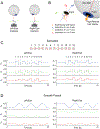A low-cost robotic oculomotor simulator for assessing eye tracking accuracy in health and disease
- PMID: 35948762
- PMCID: PMC9911554
- DOI: 10.3758/s13428-022-01938-w
A low-cost robotic oculomotor simulator for assessing eye tracking accuracy in health and disease
Abstract
Eye tracking accuracy is affected in individuals with vision and oculomotor deficits, impeding our ability to answer important scientific and clinical questions about these disorders. It is difficult to disambiguate decreases in eye movement accuracy and changes in accuracy of the eye tracking itself. We propose the EyeRobot-a low-cost, robotic oculomotor simulator capable of emulating healthy and compromised eye movements to provide ground truth assessment of eye tracker performance, and how different aspects of oculomotor deficits might affect tracking accuracy and performance. The device can operate with eccentric optical axes or large deviations between the eyes, as well as simulate oculomotor pathologies, such as large fixational instabilities. We find that our design can provide accurate eye movements for both central and eccentric viewing conditions, which can be tracked by using a head-mounted eye tracker, Pupil Core. As proof of concept, we examine the effects of eccentric fixation on calibration accuracy and find that Pupil Core's existing eye tracking algorithm is robust to large fixation offsets. In addition, we demonstrate that the EyeRobot can simulate realistic eye movements like saccades and smooth pursuit that can be tracked using video-based eye tracking. These tests suggest that the EyeRobot, an easy to build and flexible tool, can aid with eye tracking validation and future algorithm development in healthy and compromised vision.
Keywords: Eye robot; Eye tracker; Ground truth eye movements.
© 2022. The Psychonomic Society, Inc.
Figures










References
-
- Basmak H, Sahin A, Yildirim N, Papakostas TD, & Kanellopoulos AJ (2007). Measurement of angle kappa with synoptophore and Orbscan II in a normal population. Journal of refractive surgery (Thorofare, N.J. : 1995), 23(5), 456–60. - PubMed
Publication types
MeSH terms
Grants and funding
LinkOut - more resources
Full Text Sources
Research Materials

